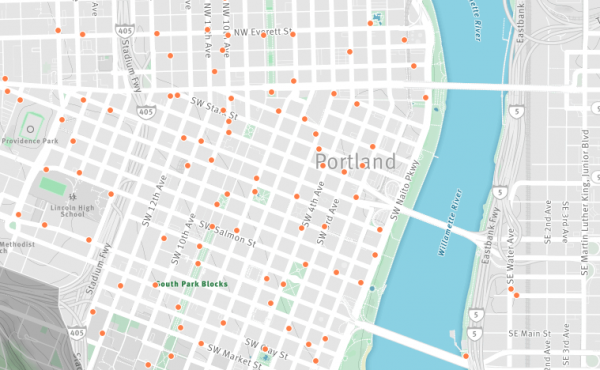
(Image from the city’s feedback website)
Though other cities have seen some memorable freakouts about the prospect of bike sharing stations, Portland hasn’t yet heard many loud complaints that Biketown stations would begrime beloved public spaces.
TriMet, for example, said last week that although it doesn’t allow blue bike “staple” racks on its downtown transit mall (more on that below), it won’t have a problem with orange bikes being parked there.
But so far, there’s one major city department that’s been keeping its distance from bike sharing: Portland Parks and Recreation.
Of the 300 locations being considered for Biketown’s first 100 stations when the Portland Bureau of Transportation launches the system in July, almost none of them appear to be on land controlled by the Parks Bureau.
On some locations, the result is merely odd. Jamison Square, for example, is a major attraction in the heart of the Pearl District, probably BikeTown’s highest-demand residential area and very important to its future revenue. But if the station location proposed across the street doesn’t work out for some reason, the city-owned land in the square is apparently unavailable as a backup.
There’s one large site, though, where the lack of Biketown stations in parks starts to seem seriously disruptive: Waterfront Park. At Salmon Street Springs, for example, a private bike rental company lines its bikes up just south of the plaza all summer. But getting to the closest proposed public bike share station will require people to wait through the unusually long light cycle to cross Naito Parkway. Then it’ll take another cycle to get back to the waterfront, if someone happens to want to ride there.
The same is true at Skidmore Fountain, where the Saturday Market sets up shop all summer.
Is there no room for bike share stations in Waterfront Park’s 30 acres? We asked Parks spokesman Mark Ross. Here’s what he wrote on March 24 (with our emphasis added):
PBOT and PP&R are working together to find the best sites for BIKETOWN locations on PP&R property, or that serve public parks by being nearby in rights-of-way.
Finding space for a pod of bikes is a complex process, requiring identification of an area where this service would be beneficial, and then balancing space needs, safety considerations, and existing activities. We want to explain the complexity of finding a location and all the variables that need to be weighed to help put this conversation in perspective for everyone. It’s not as simple seeing an open area and plunking down a bike share station!
PP&R is very open to the concept of having bike pods if they can work with a specific space, but city parks are generally designed to balance activities that are programmed in (fountains, playgrounds, etc.) and some open space (meadows, benches, etc.) with a specific intent for those spaces to be left open. Maintaining that combination of active and passive space for different types of uses is what makes a park successful, used, and serve the most people. Putting new things into a park that’s already planned with this balance takes careful consideration. Open space has value, just as it is. So, we do not let that open space be used for other active uses without giving it measured thought.
“Waterfront Park is quite long, of course, but it is also quite narrow; and the needs for all park visitors must be considered.”
— Mark Ross, Portland Parks and RecreationPP&R and PBOT have looked at specific sites in Waterfront Park. Waterfront Park is quite long, of course, but it is also quite narrow; and the needs for all park visitors must be considered when making such a decision. The park has many events that use large swaths of the park at various times. The specific locations that PBOT asked us to consider were Saturday Market and Salmon Springs, specifically because they are busy places where people congregate. But because they are busy places, finding space for a pod of bikes with clearance for the activity they would generate was difficult. So after we gave these locations (and several other downtown parks) quite a bit of consideration, we concluded that there was not room for BikeTown stations, given the footprint needed, other activities in those areas, and maintenance access needs, among other considerations. But that has led us to other options, now under consideration.
PBOT and PP&R are taking a look at two potential sites that provide direct access to Waterfront: 1) across Naito from Waterfront at Salmon/Naito (Salmon Springs) and 2) on the sidewalk at Ankeny Plaza (east of Mercy Corps building) – providing access to Saturday Market area.
Similarly, PBOT and PP&R looked together at potential locations in and around both Jamison Square Park and Colonel Summers Park and ultimately felt that the best locations were nearby, rather than in, the parks. The discussions continue, and we’re happy to keep you updated as news develops.
So, to summarize: the Parks Bureau is not allowing bike share stations in any downtown parks, because it feels there is no room.
Here’s the word from PBOT spokesman Dylan Rivera, who went out of his way to get in touch when he heard we were asking about bike share access in the parks:
PBOT is committed to working with Portland Parks & Recreation to find a solution for station locations that are appropriate and respect other park users. PP&R has been a very engaged and cooperative partner.
Advertisement
TriMet worries about design inconsistency but predicts stations on Transit Mall
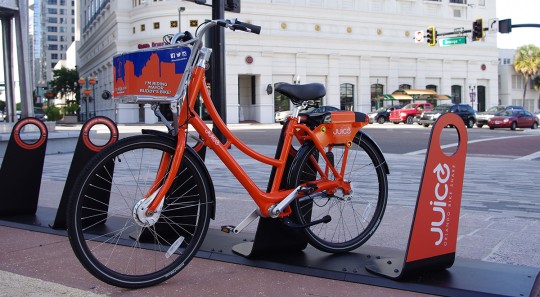
(Photo: City of Orlando)
There’s a large and ever-growing body of evidence that mass transit users are the biggest single constituency for public bike sharing, and that one of the most important effects of public bike sharing is to make it more convenient to use mass transit.
What’s more, bike sharing seems like a perfect way to mitigate one of TriMet’s longtime operational challenges, which we covered just yesterday: getting people to avoid overcrowding MAX trains with their personal bikes.
So it might seem a little odd that so few Biketown stations are being considered directly on the Portland Transit Mall — the stretch of 5th and 6th avenues that carry almost all the MAX and bus traffic through downtown Portland.
But in an interview last week, TriMet active transportation planner Jeff Owen said TriMet, which plans changes on the mall in partnership with the city and landowner-funded Portland Mall Management Inc., has no problem with bike sharing stations there.
“We’re really supportive — it can do a lot of great things for us,” TriMet active transportation planner Jeff Owen said in an interview last week. “I think we’re totally anticipating good locations for the Mall. … We’re totally excited and knowing that there’s going to be good spots along the Mall.”
That’s a significant endorsement. When TriMet remodeled the Mall in 2009, it paid to remove the standard city bike racks there and use sharper-edged stainless steel ones instead, to be more visually consistent with other features of the Mall.
“There’s a lot of partners — the city, TriMet and others, businesses, Mall Management and others — that put a lot of time and money into the way the Mall feels, operates and looks,” Owen said last week.
But Owen said his understanding is that the station racks of the new Biketown system will be relatively generic.
“I don’t really anticipate much of an issue.”
— TriMet active transportation planner Jeff Owen on bike-share stations on the Transit Mall
“It’s just the bikes themselves that are bright orange,” he said. “Obviously riders’ bikes are going to be all kinds of different colors.”
He said TriMet and Portland Mall Management have avoided any firm commitment to allow bike share stations on the Mall because “we haven’t seen renderings of stations on the Mall.”
“I don’t really anticipate much of an issue, to be honest,” Owen said.
Most of TriMet’s concerns about station placement, Owen said, will come down to operational details like whether a station location might encourage people to bike on the wrong side of the street.
“If you just go out there for a few minutes and watch people, it doesn’t take long before someone on a bike is either operating in the middle lane or on the right side, where the buses and trains are operating,” Owen said. “There might be a location or two where we say we totally understand a customer’s desire to transfer here, but we’d really like to see it on the other side of the road.”
Tonight at 2033 NW Glisan, Portland is hosting the fourth of five open houses to discuss possible Biketown station locations. If you’d like to weigh in on where those stations should or shouldn’t go, you can attend that or the final open house on Thursday in North Portland or enter feedback digitally using the city’s online mapping tool.
If you’d like to contact Portland Parks and Recreation about their position on stations in the parks, you can email Director Mike Abbate at director.abbate@portlandoregon.gov or Commissioner Amanda Fritz at amanda@portlandoregon.gov.
— Michael Andersen, (503) 333-7824 – michael@bikeportland.org
BikePortland can’t survive without subscribers. It’s just $10 per month and you can sign up in a few minutes.

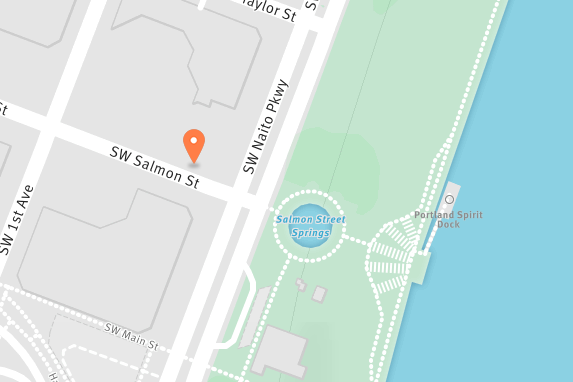
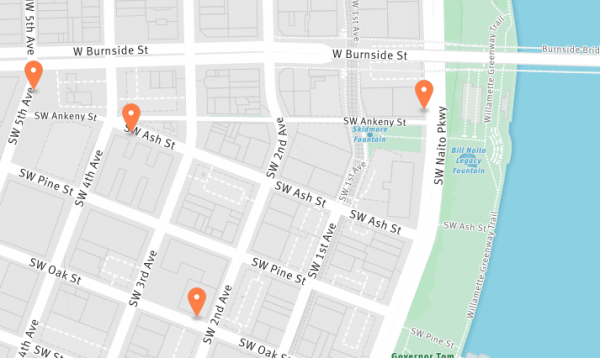
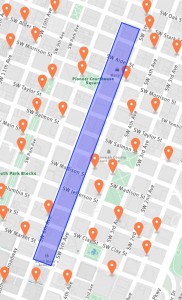
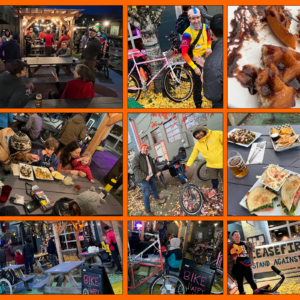


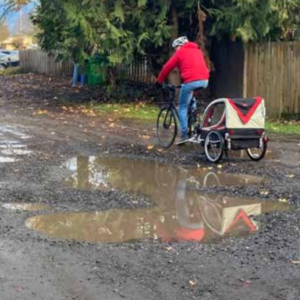
Thanks for reading.
BikePortland has served this community with independent community journalism since 2005. We rely on subscriptions from readers like you to survive. Your financial support is vital in keeping this valuable resource alive and well.
Please subscribe today to strengthen and expand our work.
Funny, PP&R can find time and room for no end of drunken orgies masquerading as festivals, but no room for bicycles. Quite frankly I would have thought public bikes would provide more utility to more Portlanders than those festivals that fence off most of Tom McCall Waterfront Park for much of the summer.
Everyone, this is long, but please put down the pitchforks for a moment and read it.
That was my first thought, how much room does a bike corral or cluster of staples take up?, but then I realized the problem is likely rebalancing. One of the unfortunate downsides of bike share is that, much like public transit, you have peak hours AND peak directions. Stations A, B, C might empty out in the morning, or on Saturdays, or on Blazers nights, meanwhile Stations D, E, and F fill up. For bike share to be reliable, those bikes have to be rebalanced; in other words, someone has to drive a truck around town picking up bikes where they’re not needed at the moment and dropping them off where they are.
The upside to a “smart bike” system is that at least we don’t have to worry about stations filling up in the same way that “dumb bike, smart station” systems do. That is, you won’t be unable to park a bike because the dock is full (although there is still some limit to that, depending on the number of other staples and poles in the “station” area). But we’ll still have the opposite problem: not enough bikes to serve demand in other spots. There is chatter about a flex pricing system where you could get a discount or even make a small amount of money by picking up a bike in a low demand/high supply area and parking it in a high demand/low supply area, and we could have a “fleet” of underemployed/bored individuals balancing bikes one by one around the city, but there’s no way that would be sufficient, particularly at rush hour and special events.
So I suspect the problem is not people dropping off/picking up up bikes, setting up a bike share account, those types of normal user activities, it’s “where do we park the truck while it’s loading/unloading?” Salmon Springs, for example. We’re trying to make Better Naito permanent, which would require a Naito road diet. Do we have the truck park in the bike lane? In the one remaining lane of traffic? Should it pull up into the park itself? What if it parked on the opposite side of the street and carried bikes two by two across Naito to the station? You have to admit these are all pretty unreasonable/impractical solutions.
One possible solution? Ditch the trucks and utilize bicycle freight. It would be slower and less efficient, but the cost should be similar (with the benefit of more money going to people’s salaries, less to fueling and maintaining trucks), and it definitely would be lower impact. I wouldn’t want a truck driving up into Salmon Spring or into Col Summers Park, but wouldn’t mind a cargo trailer doing so.
Thanks for the excellent thoughtful comment. My first thought on reading the article was, yeah, okay, that makes sense: there are some real limitations to Waterfront Park–given that the endless “festival” season is an unchangeable reality. (I agree with the first commenter, Matthew, however, in wishing it were otherwise.)
It’s a shame the Parks guy didn’t mention trucks and rebalancing. Almost like he wasn’t even thinking of that issue.
I fully expect Parks’ decision to come back to bite them when hundreds of the park-anywhere bikes end up locked to the fence along the river.
The bikes aren’t “park-anywhere.” They have to be returned to at least the same block face of one of the bikeshare stations. I would imagine that anyone who leaves their bike somewhere away from a station would be charged some kind of extra fee.
That’s correct. The charge for similar systems is like $1 or $1.50.
official language “For an extra fee, you can park at any bike rack within the service area.” I can see myself installing a bike rack in front of my house and paying the money sometimes. I can’t help but feel like the fee should be proportional to how long it takes someone else to take the bike
I thought that was the whole point of the ‘smart-bike’ system.
The bigger benefit to the smart-bike system is that people will be able to park at racks *near* the official rack. As long as it’s on the same block face, there won’t be a fee.
I couldn’t agree more. Those festivals tear up the park, and make it unusable for long periods during the summer. Follow the $$$, those festivals pay someone in the Parks department.
Wait: which council member is in charge of Parks? Maybe she’d like to get some emails.
Quoted for emphasis:
If you’d like to urge Portland Parks and Recreation to rethink its position on stations in the parks, you can email Director Mike Abbate at director.abbate@portlandoregon.gov or Commissioner Amanda Fritz at amanda@portlandoregon.gov.
“we concluded that there was not room for BikeTown stations”
Theyre talking about @^#%$ bike racks
Parks Bureau just says no to bikes. Not surprising given their stance on MTB use in the parks. What surprises me most about this is that they haven’t yet just banned bikes outright from all parks.
Yes – I agree – anyone surprised by this decision is not familiar with Amanda Fritz’s history of not being bike friendly.
For example: ““I may support a bike sharing program downtown when I see bike riders using downtown streets and sidewalks in a safe manner” (unlike the cars).
And then you look at her role in the history of mountain biking in Portland and it only makes the argument stronger that she really is holding back bicycles in this town.
Thanks Amanda for being so consistent! Can we start electing people that actually represent the Portland population and not this current crop of city officials that seem to only cater to some small, very vocal, well-funded minority that reflect their own demographic?
Seems way premature to criticize Amanda Fritz when the article doesn’t even name her as being part of this decision. Why not start out being positive and assume that we have her on our side?
She heads PP&R, which the article names. I am not “starting out” positive because she has a long history of being negative and I have a long history of watching bike politics unfold in this city.
Perhaps you can “start out” positive based on your own ignorance, but I have been involved and watched bike politics in this city for many years.
Yeah, I’m aware of what she’s said and done in the past.
My comment is more about tactics. Even if you’re exactly right, I don’t see how slamming her before she’s even spoken publicly on this point helps advance the goal of getting bike share in parks. And if you’re at all inaccurate in seeing her direct fingerprints on this decision, then you’ve just succeeded in spreading misinformation and further alienating a potential resource.
She is head of PP&R and holds at least some accountability of the decisions they make. If she speaks out against the decision of PP&R, it still reflects poorly on her for not knowing what is going on in an organization she is responsible for running or she is basically admitting to internal conflicts. Either way, it doesn’t speak well for her.
I don’t think me going in it negatively is going to affect the outcome at all. I have seen _way_ too many situations she has pulled the rug out from underneath them and they have gone into situations with a positive attitude.
At this point I don’t consider her a resource for cycling in Portland – I don’t think anyone does. So, if you want to talk political tactics, let’s talk about tactics to get some new people in City Council – starting with her and Nick Fish.
Why is PP&Rs position on homeless camps not consistent with their position on bike racks? Seems like they would have similar concerns. Just re-read their statement but substitute “homeless camp” for “bike”.
Stand by Pedalpalosa. Parks bureau will ban all bikes from all parks next. Especially downtown, Summers, and Holiday.
Wait: what is the size, or how large of space do the stations require?? I understand you’ll be able to return bikes near the vicinity of a station, but I’m wanting to know what the actual size of a station is to counter the concerns PP&R references — the spokesperson references “finding space for a pod of bikes with clearance for the activity they would generate…” and “…concluded that there was not room for BikeTown stations, given the footprint needed…” what is the size of the footprint PP&S is referencing?
To be fair, here in NYC you won’t find Citi Bike Stations inside public parks despite tremendous recreational demand as well as the fact that Central Park and Prospect Park serve as commuter routes for lots of New Yorkers.
There are a few reasons for this:
1. NYC Parks Department-run parks are closed at night and Citi Bike is meant to be a 24-hour system. (If I recall correctly from my visit to Portland, Waterfront Park is technically closed to the public late at night.)
2. Preservation of open space.
3. Sensitivity to corporate logos inside city-run parks.
You will find bike share docks immediately *outside* parks or, in some cases, across the street or a block or two away, just as it looks like will happen with Waterfront Park.
Looks like some valid concerns, thanks for sharing this perspective.
The water front trail and the eastside esplanade are considered transportation corridors and, as such, even though they are inside a park, or managed by parks, they are open 24/7.
“the needs for all park visitors must be considered when making such a decision.”
Funny how the needs of one set of visitors isn’t being considered.
I would love to see bikeshare stations use some of the street space as part of a refreshed Naito Parkway design. I’d rather preserve the park space and use the opportunity to narrow the roadway on Naito, or rather *expand* the park a bit further out into Naito with the two way MUP and bikeshare stations along the eastern side of Naito. Solve two problems at the same time.
Probably don’t need the proposed one right outside of my house!
according to BikeTownPDX website the draft station location map includes the south end of Waterfront park near the bowl/ampitheater next to Riverplace, the South Waterfront Park just south of the Riverplace area — both along the Waterfront Park Trail which is a MUP, is it not — and both under PP&R purview, are they not? Not to mention another draft location on the Eastbank Esplanade near Hawthorne Bridge — another location under PP&R control is it not?
According to PortlandMaps, South Waterfront Park is actually owned by the PDC (who funded its construction). Similarly, the Eastbank Esplanade was funded by the PDC, although at a glance it’s not clear who owns it. I assume Parks manages both assets, but they may not have the same veto power over what gets placed them. But IDK.
The “bowl” at the south end of Waterfront Park is, of course, home to the annual WF Blues Festuval in July. In recent years, a temporary parking area for bikes which is protected and maintained by volunteers has usually been placed just south of the Naito & Clay St. Entrance gate. This year, they are expecting an increase in bike commutes to and from the festival with the addition of access via Tilicum Crossing and the Hooker St. MUP to access the Ruverplace path to that entrance. Seems to me that the Clay St. location would make sense as a Biketown station site.
Huh. It is disappointing that PP&R isn’t figuring out how to make this work.
I’m just about positive that many of the Nice Ride stations here in Minneapolis are on MPRB property, since one of the drawing cards is the ability to ride them on our extensive bikeways located in parks, including the Grand Rounds. I’ll double check on some of them this week, but it sure looks like they’re on Parks property.
I’ve been working closely with members of the parks department regarding regulations and permitting and I’m pretty freaking 99.9% sure it has nothing to do with the feng shui or “delicate ecosystem” PR bs they’re dishing out. The truth of it is, they’re looking for money. The downtown parks are in the pockets of the PBA. If you want to have an event there, ridiculous costs involved. If you want to be a vendor (even on a daily basis) you need a $75 permit in the parks (though I’m sure few get it – which can lead to hefty fines from the park rangers downtown.) Buskers? Free to play anywhere downtown Portland, but in a downtown park, the Rangers will harass you mercilessly, threatening with arrest, etc. (Because of a 17+ year old PBA guideline that PBA refuses to uphold their end of the deal which allows musicians to purchase park permits, yet the Parks can still fine for not having a permit. Huge loophole.)
We all know there’s plenty of room at the parks, while still allowing pedestrian right-of-way, access, form and function. They have a heck of a spin doctor working for them.
In my mind, the waterfront is a very low priority location. Nobody starts their trip there. Pick a bike up on the way there if you need one.
I disagree. I think the Waterfront would be an ideal location for a tourist to start and end his or her loop trip by bicycle or to start a ride to OMSI.
I think lots of people would be far more comfortable walking across Naito to begin their cycling trip than to mount up on the street and ride across Naito to begin cycling along the river front paths.
Yes. A lot of people are viewing these primarily as a tourist amenity. That could very well prove to be true.
And maybe have haven’t heard about walking a bike across a road. If not, I question their safety on the streets, or the safety of others if they’re heading to the waterfront. I think we’ve agreed to save those discussions for after deployment though.
It’s pretty annoying that PBOT’s online tool didn’t include any locations on PP&R land and it’s not possible to suggest any, so it’s not even possible to fully gauge public support for the idea.
One of the big reasons for Seattle’s disappointing first year and a half of bike share is the awful station placement. There is only one Pronto station directly adjacent to a light rail station in Seattle, up on Capitol Hill.
I suspect Kerr’s don’t want competition either, and may indeed have conditions built into their lease that provide compensation if competitors are allowed into the park.
I, like about 30% of adult Americans, don’t drink. I really, really resent the boozefests that lock up the Waterfront Park for several weeks during the summer. I ride through the park on my commute and walk through the park at lunchtime. When the lawns are fenced off, the pathway along the river is that much more crowded.
I pay a hefty chunk of my household income to the City and County in income, property and other taxes, so I dislike having public amenities coopted for additional money making ventures of city agencies. If the city can’t manage its budget properly (which it can’t) then it needs to take a soup to nuts look at every activity it is engaged in to determine where money is being wasted or poorly utilized. High on my list of budget drains would be the never ending saga of the Portland Building – the city is crappy at managing office buildings – sell it and leaseback only the minimum amount of space necessary for those workers whose jobs must be located downtown, and move the rest to cheaper locations around the city.
I have a deep and abiding hatred for the Portland Building, and for some of what it represents (not least: the lowest-bid contracting requirement that got it so badly built in the first place), but I’ll counter your off-topic comment here with a little insider insight of my own.
Silo mentality is a huge problem in the City. It’s exacerbated (hugely – really, hugely) by bureaus operating in separate physical locations. People actually meet, in person, to hash out inter-bureau issues.
The promise of tele-meeting still hasn’t been realized. People (even the public employees whose work you seem so suspicious of) do their best work in person, via relationships.
It’s conceivable that all City workers not in lab, field, maintenance and operational jobs could be co-located in some cheaper real estate outside of downtown…but then they’d be disconnected from City Hall.
I don’t want City Hall any more disconnected than it already is from the people who actually carry out its directives.
I noticed there are some diagonal parking spots right there. How many people can those serve in a day? Would a bike share station fit?
But Owen said his understanding is that the station racks of the new Biketown system will be relatively generic. “It’s just the bikes themselves that are bright orange,” he said. “Obviously riders’ bikes are going to be all kinds of different colors.”
Am I reading this right? Is Tri-Met’s official concern entirely centered on the aesthetics of the bikes locked up on the mall?
BikeTown could simply change their pricing model to exempt Waterfront Park from the non-blockface fee. No need to add stations, there are plenty of racks in the park that are under-utilized.